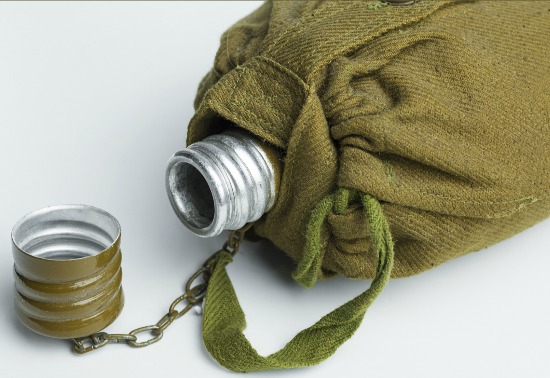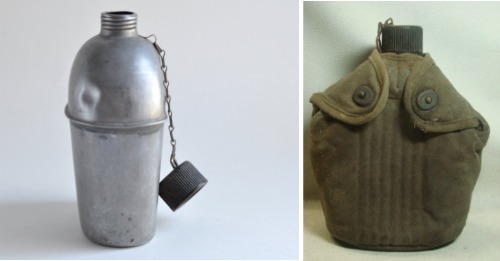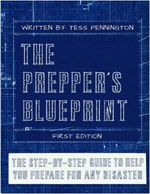This article was originally published by Jeremiah Johnson at Tess Pennington’s ReadyNutrition.com
Tess is the author of The Prepper’s Blueprint: How To Survive ANY Disaster

This article stresses the importance of finding drinking vessels that will not leach chemicals out of their very walls and poison you. Yeah! Sounds problematic, doesn’t it? Well, it is. BPAs (Bisphenol-A, a chemical used in plastics for the past 60 years). BPAs are found in both epoxy (used in food cans and even in dentistry), and in polycarbonate plastics. The latter is used in vessels that hold drinks and food. Studies have shown that BPAs affect the brain and other systems of the body. The FDA said the levels of BPA within the plastics are safe.
No. Safe is when there are no levels of such things in your food.
Fortunately, you have solutions at hand in the form of glass drinking bottles and steel bottles. I have mentioned this in the past, but there are a few things to consider here also to make your “finds” truly effective. Let’s cover them.
- If it’s glass, make sure it’s wide-mouthed and/or freeze-resistant: The problem is in the wintertime. If that glass vessel should freeze, having it wide-mouthed, and not filling it up all the way are the solutions. Leave about ¼ or more “headspace” to provide for expansion with a freeze, if it should occur. Suggestions here are for wide-mouth Mason jars (one-quart or larger). You can find them in stores that sell canning supplies, and also order them online. Glass also gives you another advantage: a glass jar with water inside and left in the sun will heat up almost akin to a “solar oven,” and for those old enough to remember Don Meredith and his “Sun-Tea” ads for Lipton…yes, it works. Put your tea bags inside and leave it out. The sun will do the rest.
- Steel: Yes, to paraphrase “Rage Against the Machine,” a “fistful of steel” will knock out those BPAs. I will give you my own preference right here: WWII issue canteens. Here’s a photo of one by itself, and also how it appears in its carrying cover:

These guys are made of steel, and their lids have a cork liner…if it’s gone, you can easily replace it.
No leaching of the plastic, and no aluminum or aluminum blends. In the wintertime, fill them up to about 2/3 capacity, and they’ll take the freeze. Even better: you can place them on the coals of a fire and your ice will then thaw out. Look for these guys in your local military surplus stores, or you can order them and the carrying covers online at Amazon.
Just pay attention, because in ‘45 Uncle Sam started making them out of aluminum. It will be stamped on the bottom (the date), and it’ll take a magnet if it’s steel and not aluminum.
Another “plus” is the fact that you can hook these guys up to your vest or military gear. You may have to attach Alice clips in order to do it, but that’s no large feat.
Both glass and steel bottles are easier to clean and prevent “detritus” from remaining or forming a film, as is wont to do on surfaces that are made of plastic. Both stand up to heat better than plastic and will not catch on fire…another “plus” to file away. As they do not break down as readily, you don’t have to worry about chemicals leaching with the passage of time. I recommend both to you. It is trickier with glass to protect it from being broken, but why not use some of these insulated bottle-carriers you see on the market for plastic bottles?
If the glass bottle should break, the carrier will contain the glass for a short time and perhaps prevent cuts. In addition to this, the Mason jar (if used) can stand up to the heat. You can make up some stew in a pot, and use the Mason jar to eat a nice bowl of soup. Then it’ll clean up just fine and can go back to being used as a drinking vessel. You’re only limited by your imagination, but as the winter approaches, keep in mind: your need to drink does not decrease. Arm yourself with these tools and try them out until they become second nature and a part of your daily routine. JJ out!
About the Author
Jeremiah Johnson is the Nom de plume of a retired Green Beret of the United States Army Special Forces (Airborne). Mr. Johnson was a Special Forces Medic, EMT and ACLS-certified, with comprehensive training in wilderness survival, rescue, and patient-extraction. He is a Certified Master Herbalist and a graduate of the Global College of Natural Medicine of Santa Ana, CA. A graduate of the U.S. Army’s survival course of SERE school (Survival Evasion Resistance Escape), Mr. Johnson also successfully completed the Montana Master Food Preserver Course for home-canning, smoking, and dehydrating foods.
Mr. Johnson dries and tinctures a wide variety of medicinal herbs taken by wild crafting and cultivation, in addition to preserving and canning his own food. An expert in land navigation, survival, mountaineering, and parachuting as trained by the United States Army, Mr. Johnson is an ardent advocate for preparedness, self-sufficiency, and long-term disaster sustainability for families. He and his wife survived Hurricane Katrina and its aftermath. Cross-trained as a Special Forces Engineer, he is an expert in supply, logistics, transport, and long-term storage of perishable materials, having incorporated many of these techniques plus some unique innovations in his own homestead.
Mr. Johnson brings practical, tested experience firmly rooted in formal education to his writings and to our team. He and his wife live in a cabin in the mountains of Western Montana with their three cats.
Tess Pennington is the author of The Prepper’s Blueprint, a comprehensive guide that uses real-life scenarios to help you prepare for any disaster. Because a crisis rarely stops with a triggering event the aftermath can spiral, having the capacity to cripple our normal ways of life. The well-rounded, multi-layered approach outlined in the Blueprint helps you make sense of a wide array of preparedness concepts through easily digestible action items and supply lists.
Tess is also the author of the highly rated Prepper’s Cookbook, which helps you to create a plan for stocking, organizing and maintaining a proper emergency food supply and includes over 300 recipes for nutritious, delicious, life-saving meals.
Visit her website at ReadyNutrition.com for an extensive compilation of free information on preparedness, homesteading, and healthy living.









0 Comments